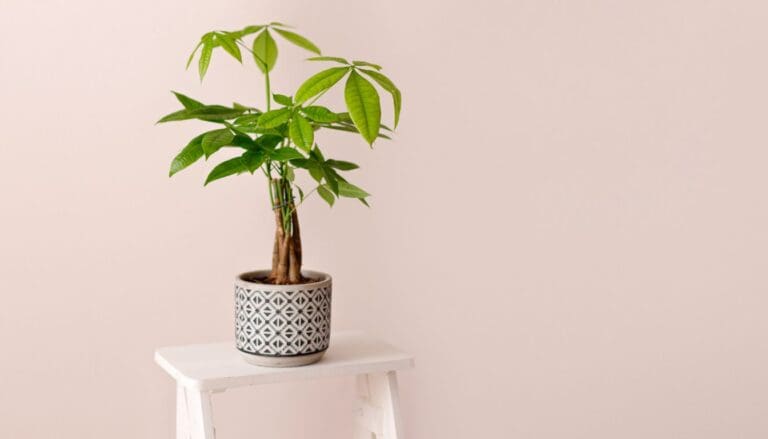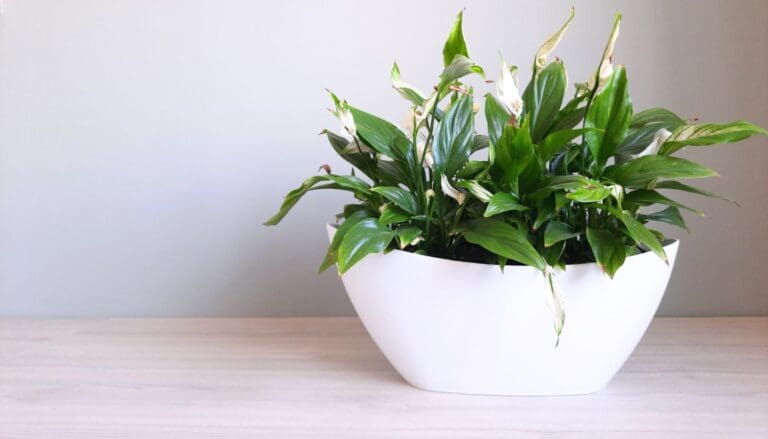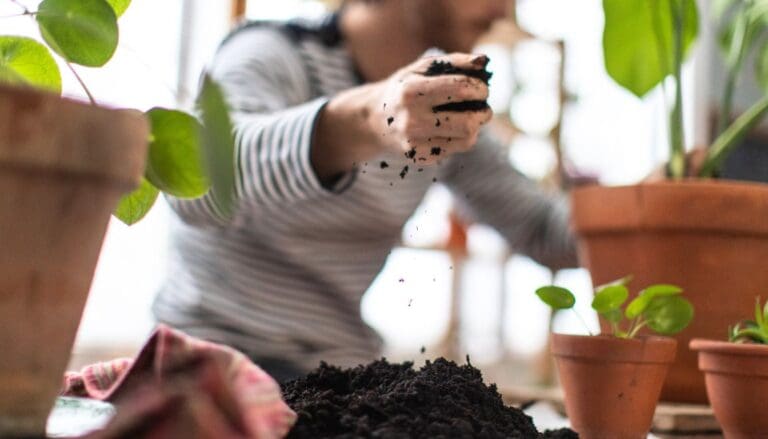White Spots On Philodendron Leaves? Try This!
Philodendron (genus, Philodendron) is a kind of flowering plant that belongs to the Araceae family. These can be grown as both indoor and outdoor plants. But, they have their problems if not taken care of or if their surrounding environment is unsuitable for the plants. One common problem is white spots on the leaves.
A pest infestation, fungal infection, low lighting conditions, cold temperatures, and poor ventilation are common causes of a philodendron’s white spots. Spray neem oil on your philodendron to keep the pests away, provide sufficient indirect light, and keep them away from cold drafts.
Identifying the problem can seem challenging, but you can fix the problem and cure your philodendron once you identify the issue.
Now let’s discuss the causes of white spots in detail.
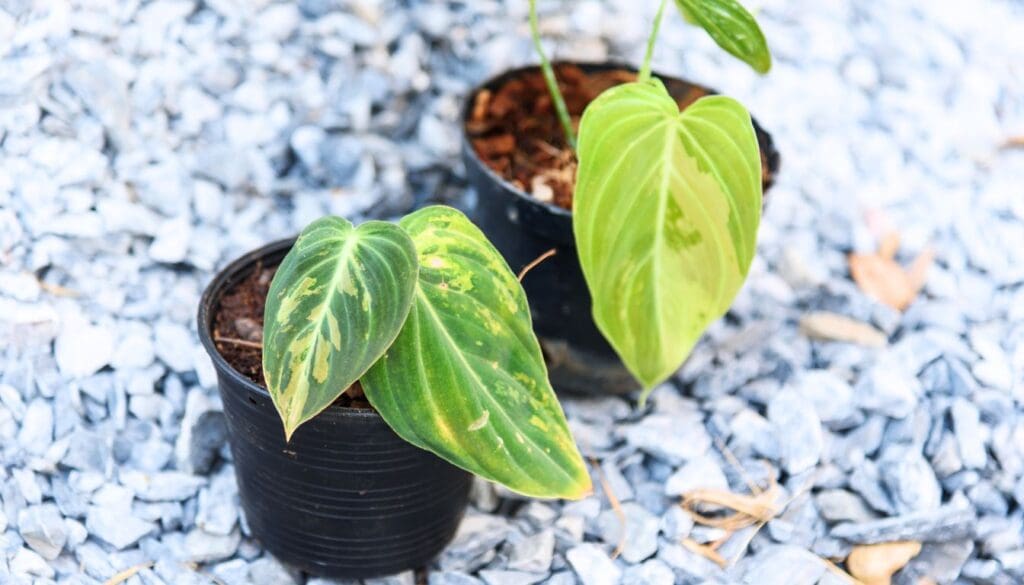
Please note: Simplify Plants is reader-supported. Some links in the post are affiliate links and I get a commission from purchases made through links in the post.
What are the causes of white spots in philodendrons?
Some reasons or causes of these white spots in the philodendron plants can be:
- Pest infestation
- Fungus attack
- Low light
- Low-temperature issues
- Poor water quality
- Lack of fertilizers
There may be more reasons behind white spots other than those mentioned above. But these are some of the widespread problems behind the white spots in philodendrons.
Now, let us elaborate on these issues and discuss their treatment.
1) Pest Infestation
Pests are tiny insects or bugs that attack and destroy plants. Some common pests attacking philodendrons are:
Mealybugs: Mealybugs are tiny bugs that suck out all your plant’s nutrients, thus making the plant weak. These bugs leave out some white powder-like substance that looks somewhat like cotton, and they mainly attack tropical plants.
Mealybugs are primarily seen in the leaves, stems, or branches of plants. You can even call them vampires for the plants, as they suck out the life of the plants, pushing the plants to death.
To get rid of these mealy bugs, you can use some horticulture oils, like neem oil. It works very well to eliminate these bugs and won’t even allow them to return. You must also cut off the affected leaves of your philodendrons so that it doesn’t affect any other leaves or plants near it.
Spider mites: Spider mites are very tiny to look at, and it is pretty impossible to see them from a distance.
But if you suspect that your philodendron is affected by spider mites, take a much closer look at the plants or leaves, and you can see spider webs on them. Then you know that your plant is affected by spider mites.
Spider mites leave a whitish tint on the leaves. So when you see this tint, do give your plant a close look.
To eliminate the spider mites, first of all, clean those webs. Remove those webs with a hand (gloves recommended) or with some paper. Then give your philodendron a good wash with clean water.
Try to keep your plants a little wet. As these spider mites are like dry places, keeping the leaves a little wet won’t allow the leaves to grow more webs. You can use neem oil to protect the leaves from these spider mites. It is an excellent solution for most of the problems in plants.
Aphids: These are tiny bugs that feed on the sap of the plants, thus making the plant weak. They leave some white fuzzy substance on the leaves, thus making white spots on most parts of the leaves.
They affect the plants like the mealy bugs, leaving a white substance behind. They are slow killers. They slowly kill the plants.
To get rid of these aphids:
- Give your plant a good wash with clean water, and then spray neem oil solution on the leaves.
- Do not wash away the solution.
- Let the solution remain on the leaves for some time.
- Keep your philodendron isolated for some days.
Thrips: Thrips are another kind of pests that can be the reason for white spots on the philodendrons. They look like needles, and they come in different colors, like yellow, brown, or black. They, too, suck the sap of the plants, making the plant weak, twisted, and discolored.
Thrips leave silver dots on the plants, which can be seen as white spots from a distance. Thrips also attract other viruses to the plants, thus causing more damage to the plants. So, you need to get rid of them quickly.
Again, you can use neem oil solution here too, to get rid of such rigid pests. It is one of the best solutions to most of the problems related to plants.
Another option is soap water. You can use any soap, like bathing soap or dishwashing soap water, to get rid of these thrips from your philodendrons. Also, keep your affected philodendron away from other plants to avoid affecting the other plants.

2) Fungus attack
The fungi that attack the philodendrons, leading to white spots on the plants, are:
Powdery Mildew: You can identify this fungus by seeing a fluffy white substance, a somewhat powder-like substance, on the leaves of your philodendron.
Powdery mildew is a common problem in almost all plants. That’s why it is called powdery mildew. It looks like some talcum powder spread over the leaves. They create white spots on the leaves, and the spots increase gradually. If not treated, these can severely damage your plant.
To get rid of this powdery mildew, you must first act fast by preventing the spot from spreading. Then, cut off the affected parts of the plant.
Keep your philodendron away from other plants so that it doesn’t spread. Use neem oil solution and keep spraying on the leaves to avoid further powdery mildew. Also, place your philodendron in a place containing proper airflow.
Sometimes, we keep our plants in the corner of our balcony, for which the plants fail to get enough air that is needed for them. So, we need to change the affected philodendrons, where they get proper air, so that the damp weather can prevent the fungus growth.
Leaf Spot Disease: Leaf spot is a disease seen in the philodendrons caused by some outside fungus. It leaves white and yellow spots on the leaves of your plants. You need to treat them as fast as possible.
It is a kind of disease that can spread very easily and quickly. It is mainly caused by the overwatering of the plants. Excessive dampness can give growth to this kind of disease.
To fix this problem:
- Ensure that it doesn’t spread much.
- Remove the plant from other plants.
- Just eliminate those affected leaves to stop the disease from spreading to the other leaves.
- Provide proper water, air, and sunlight suitable for them. Excessive watering can bring the disease back into the plant.
3) Root Rot
Different types of root rot can occur in a philodendron. This is generally caused by overwatering them. You cannot identify it unless it leaves white or yellow spots on the leaves of your philodendron.
When you see these white spots, you must check the roots of the plants by taking them out of their containers. I think it is the best way to identify and confirm the problem behind the spots.
To fix this problem, you must remove the plant from its pot, cut the affected roots, and plant it in another fresh pot with fresh soil mix and water them with clean water.
By doing this, you can save your affected philodendron and bring it back to life. Also, you can use suitable fungicides to make the roots healthier.
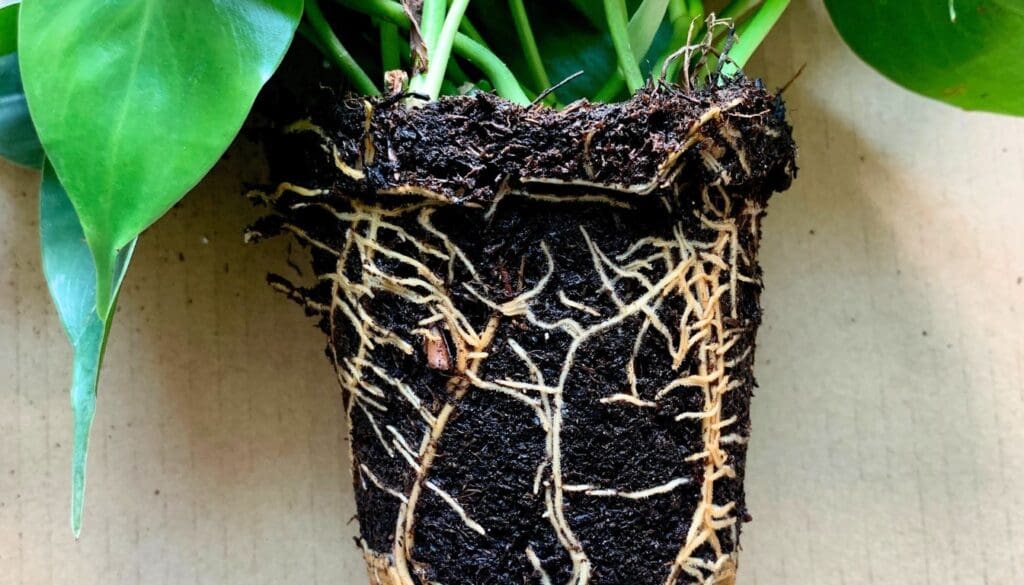
4) Low Light
Receiving low sunlight is another problem of white spots in the philodendrons. These tropical plants are habituated to a warm atmosphere, and they need warmth around them for good growth.
You will see white spots on the body of the leaves, which can occur due to a lack of proper sunlight. So, keep your philodendron in such a place where it can get the proper amount of light.
Though the plant is prone to warm weather, too much heat and warmth will kill it. The amount of light it receives must be neutral. But ensure it doesn’t get direct sunlight, as too much heat will cause sunburn, thus damaging the leaves.
Also read: What Kind Of Light Does A Philodendron Need? (Light Requirements)
5) Low-temperature issues
Philodendrons are habituated to the tropical environment and cannot survive cold temperatures; thus, they turn white.
They enjoy growing in warm weather. So, whenever you see signs of whiteness in the leaves, place your philodendron in such a place where it can receive a suitable amount of warmth for proper and healthy growth.
6) Poor water quality
Some water contains too many minerals. All these minerals accumulate in the leaves and give the leaves a white texture.
Instead of regular tap water, you can use rainwater or filtered water. Tap water may contain iron, but you can leave it outside and let it get aerated. This will reduce the amount of minerals.
Also read: How Much Water Does A Philodendron Need? (Water Requirement+How Often)
7) Lack of Fertilizer
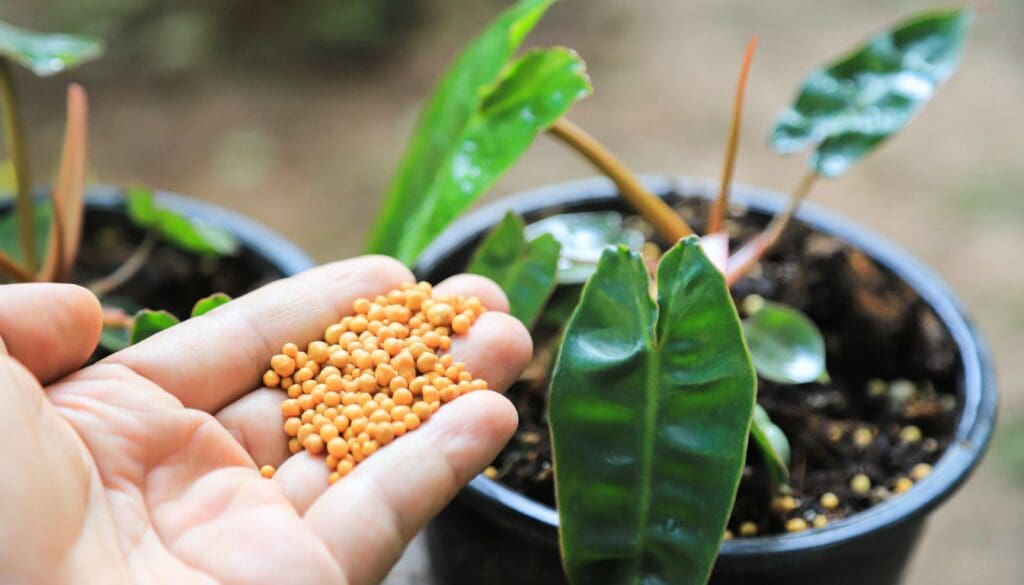
Every plant needs proper fertilization to remain healthy and appealing. If you don’t fertilize your plants, they will not look appealing or strong.
Fertilizers contain a good amount of nutrition that is needed for the healthy growth of the plants. The two most essential micronutrients needed for philodendrons are calcium and magnesium.
Calcium is one of the critical micronutrients needed for the proper growth of philodendrons. But, poor quality water contains too many minerals. Too many minerals can lead to a whitish tint effect on the leaves.
So, to give calcium to your philodendron, you must use the right fertilizer that contains the right amount of calcium needed for the healthy growth of your philodendron.
Another vital micronutrient for philodendron is magnesium. Lack of magnesium in your philodendron can lead to white spots on the leaves and even yellowing. The condition of yellowing of leaves in philodendrons due to lack of magnesium is also called Chlorosis.
Epsom soil contains a good amount of magnesium. To avoid this situation, you can put some amount of Epsom salt in the soil. This will help the philodendron plant receive the proper magnesium, thus resulting in healthy plant growth.
Also read: What Kind Of Fertilizer For Philodendron? (Best Fertilizer+Fertilizer Ratio)
How can I prevent white spots on my philodendron?
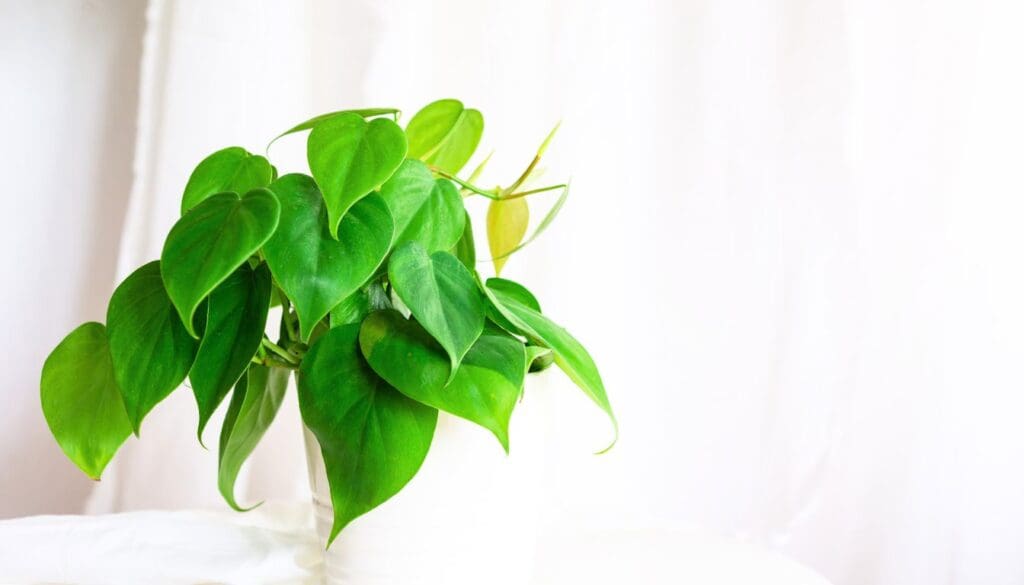
Previously, we have discussed how to fix the problem of white spots after their occurrence. But here, we will discuss how you can prevent these problems from occurring.
In short, the precautions that should be taken to prevent these problems.
If you take proper care of your philodendron, then the white spots will not be seen.
Air: You must position your plant so that the plant gets the proper amount of air. Sometimes we keep our plants in corners of the house or balcony. Thus, the plants lack enough air circulation leading to white spots.
If they get proper air, then there won’t be any white spots. So, a good amount of air is necessary.
Water: You must give the right amount of water to the philodendrons. But keep in mind that overwatering can harm your plant and can rot the roots of your philodendrons.
Avoid using water containing excess minerals because that can leave white marks on the leaves.
Sunlight: Philodendrons are native to tropical environments. So, the plants must be kept in such a place where it gets indirect sunlight. Getting a warm environment will help the plant grow well, and it will also prevent white spots, pests, and fungus attacks on the philodendrons.
But remember, don’t keep it in direct sunlight because excessive heat can lead to sunburn of the leaves and damage.
Fertilizers: You must use enough fertilizers for your philodendrons to grow well, be healthy, and make them look appealing.
Calcium and magnesium are two crucial micronutrients that philodendrons need. So, using a suitable fertilizer containing these two micronutrients can help grow your philodendrons healthy and appealing. Otherwise, they might look weak, and the leaf size will look smaller.
Removal of Excess or Damaged Parts: You must observe your plants daily to check for any signs of damage like fungus attack, pest attack, or any disease. If you see such things, you must immediately prune those damaged parts to prevent further damage to your philodendron.
Also, you must keep them away from other plants. If needed, spread some neem oil to prevent further damage.
Repotting: Sometimes, you must shift your philodendron from one pot to another. Shift them to another new pot with some fresh soil and water.
This will help prevent the white spots on leaves and even root rotting of the philodendrons.
Some tips for a healthy philodendron
- Keep your plant where there is a warm environment and indirect sunlight.
- Keep your philodendron away from cold weather.
- Avoid overwatering
- Use the necessary amount of fertilizer.
- Change the pots of your philodendrons whenever necessary.
Not just Philodendrons, if you take good care of all your plants and give them all that is necessary for them, they will always survive well and grow healthy. Happy gardening!
Ref: Wikipedia.
Recommended Garden Supplies
| Product Image | Our Recommended Gardening Supplies | Check Offers! |
|---|---|---|
Top Top
Top
Top
Top
Top
Top
Top
Top | rePotme Houseplant and Tropical Classic Potting Soil Mix | Check Offer On Amazon |
 Top
Top
Top
Top
Top
Top
Top
Top | Espoma Organic Indoor Plant Food | Check Offer On Amazon |
 Top
Top
Top
Top
Top
Top
Top
Top | GooingTop LED Grow Light 6000K Full Spectrum Clip Plant Growing Lamp | Check Offer On Amazon |
 Top
Top
Top
Top
Top
Top
Top
Top | Soil Moisture Meter | Check Offer On Amazon |
 Top
Top
Top
Top
Top
Top
Top
Top | Govee Hygrometer Thermometer, Bluetooth Enabled! | Check Offer On Amazon |
 Top
Top | LEVOIT Humidifiers for Large Room(Best For Plants) | Check Offer On Amazon |
 Top
Top
Top
Top
Top
Top
Top
Top | Upgraded DIY Automatic Drip Irrigation Kit, 15 Potted Houseplants Support | Check Offer On Amazon |
 Top
Top
Top
Top
Top
Top
Top
Top | Stainless Steel Heavy Duty Gardening Tool Set | Check Offer On Amazon |
 Top
Top
Top
Top
Top
Top
Top
Top | Bonide Insecticidal Soap | Check Offer On Amazon |
 Top
Top
Top
Top
Top
Top
Top
Top | Bonide 32 oz Spray Neem Oil for Organic Gardening | Check Offer On Amazon |
 Top
Top
Top
Top
Top
Top
Top
Top | Garden Safe Fungicide | Check Offer On Amazon |




